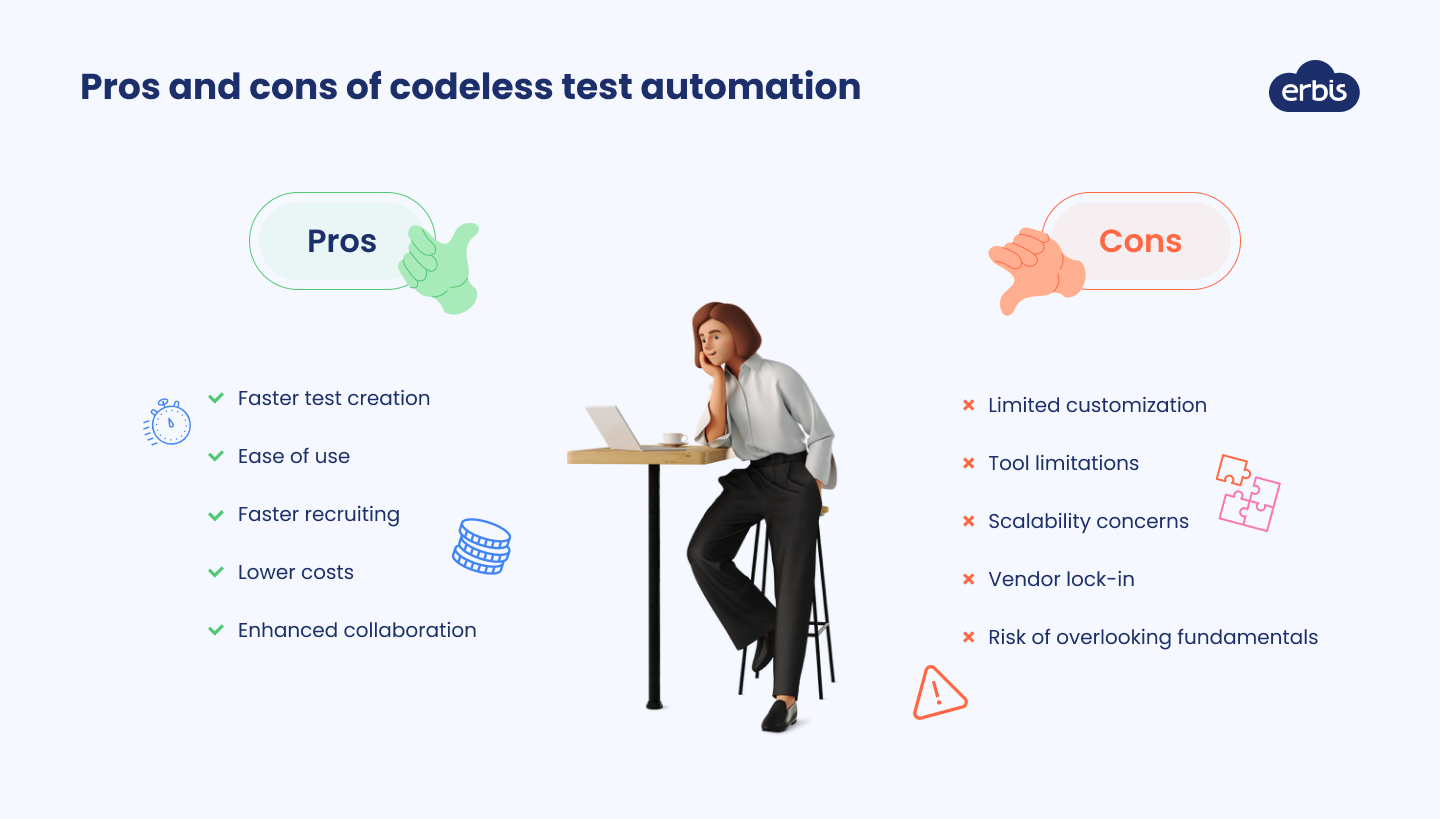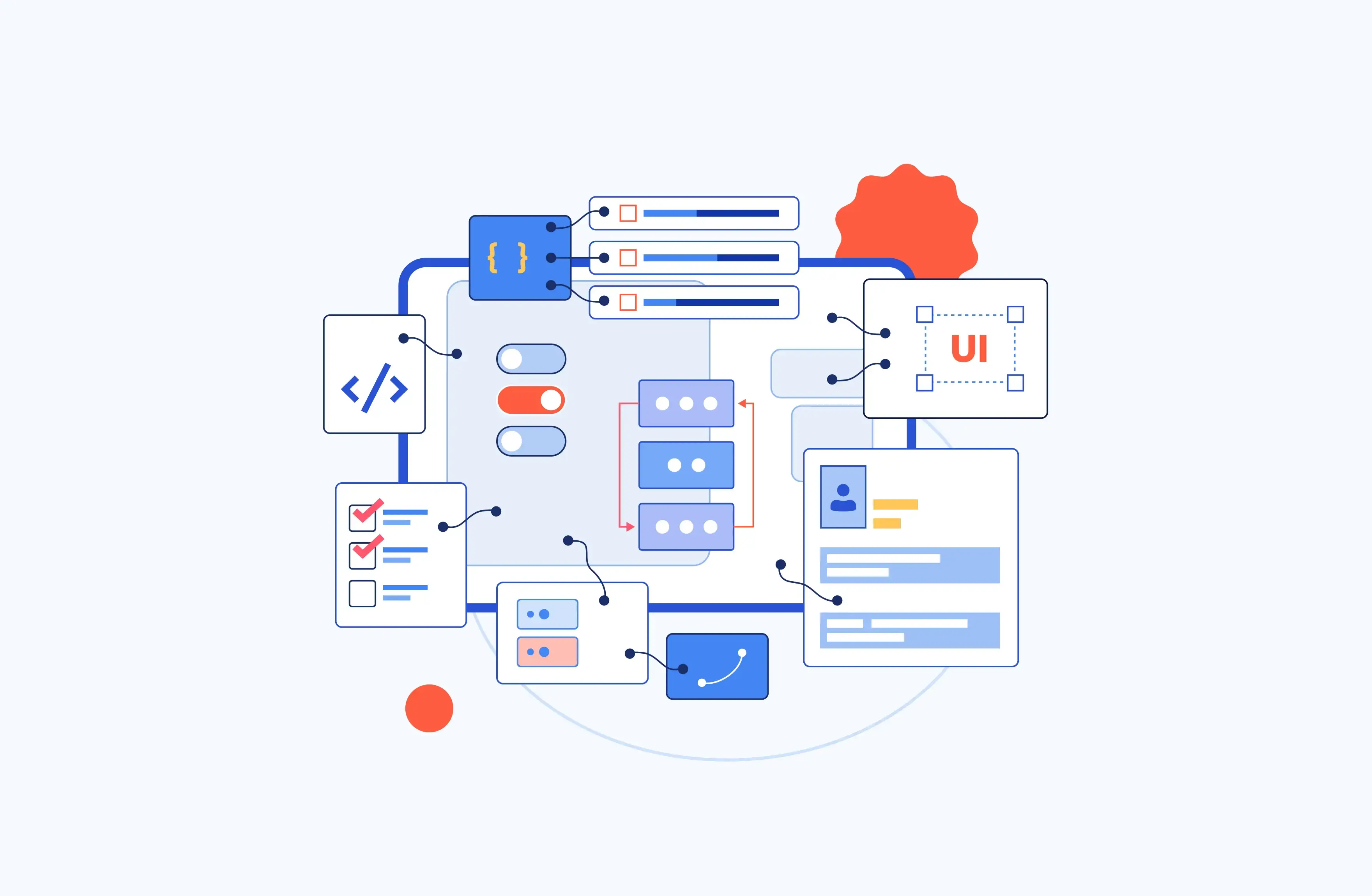Codeless Test Automation: Everything You Need to Know
You might have heard about low-code and no-code development when programs are assembled from ready-made blocks rather than written manually. But tech progress does not stand still, and programming is now far from the only area to minimize manual operations. Testing, as an integral part of the software development process, has also undergone technological transformations.
AI is increasingly being used to write test cases and scenarios for manual testing. On the other hand, QA engineers have seen the benefits of using codeless test automation.
Are you wondering what no-code testing is and whether it suits your project? In this post, we cover all aspects of codeless test implementation.
Codeless test automation: the next step in software development?
Having proved its efficiency in programming, the codeless approach has also reached testing. But what exactly is codeless test automation?
Actually, no-code testing is not much different from no-code programming. After all, what is automated testing? It involves writing a software program that tests another software program. And if programmers can use no-code tools in their work, why can't testers use the same tools to write programs that perform testing?
Codeless test automation is the next level in test automation. It allows QA engineers to create test scripts faster, run program checks faster, and get results faster.
Codeless test automation simplifies the work of the QA team and allows it to run autotests with less effort.
At the same time, no-code testing does not change the testing process itself because the software does not care whether it is tested by a program written by a person or a machine.
Looking for an efficient testing solution for your project? Consult with proficient QA engineers.
Pros and cons of codeless test automation
Codeless test automation has both advantages and disadvantages. Here's a breakdown of the pros and cons:
Pros
Faster test creation. The main reason for choosing codeless test automation is reduced time for testing. It's one thing when you write test scripts manually, and it's another thing when you assemble them from ready-made blocks. Depending on the nature of the project, you can reduce the testing time by 50% or more, advancing the release date and therefore reaching the target audience more quickly.
Ease of use. Codeless test tools have intuitive and easy-to-use interfaces. This allows testing professionals to quickly learn how to use and apply them. The user-friendly approach also accelerates mastery of the learning curve and empowers QA teams to design and execute test scenarios efficiently.
Faster recruiting. Finding test automation engineers with the right skills can take a long time. But codeless test tools require a simpler skill-set making it easier to find suitable specialists. Furthermore, you can more quickly integrate new team members into testing activities thanks to the short learning curve for codeless tools.
Lower costs. The salary of experienced automated testing specialists can reach $100.000 per year. But by using no-code testing tools, the salary budget can be significantly reduced since a specialist will need fewer coding skills, if any, and will not require as much experience or technical background.
Enhanced collaboration. Thanks to no-code tools, you can involve different specialists in testing, for example, UI/UX designers, business analysts, and project managers. This helps keep the team on the same page with project developments, eliminate communication gaps, and achieve better results faster.
Cons
Limited customization. No-code test tools might not be as flexible as custom-coded solutions and may not cover the requirements of complex projects. In this case, consider them as extra tools for conducting testing and look for QA specialists capable of writing autotests by themselves.
Tool limitations. Codeless tools might not support the required technologies, limiting the testing scope of a project. For example, they may not fully support different releases of iOS and Android, may struggle to integrate with legacy systems, or may be unable to test embedded systems with unique communication protocols.
Scalability concerns. As test suites grow, codeless tools might struggle to handle large test repositories or complex data-driven testing. This challenge can lead to increased execution times. Also, you may face difficulties in maintaining a high level of performance as the application and its testing requirements expand.
Vendor lock-in. If you run all test activities using a single codeless testing tool, you can become dependent on a particular tool vendor. In this case, if you are no longer satisfied with the current no-code instrument, you may need a lot of time and effort to switch to another provider.
Risk of overlooking fundamentals. Relying solely on codeless testing tools may result in overlooking fundamental testing concepts. While these tools streamline the process, understanding basic testing principles is crucial for QA professionals. Without adequate knowledge and expertise, troubleshooting issues effectively would be difficult.

Code-based vs. codeless test automation: key criteria for comparison
Below we provide key parameters for comparing code-based and codeless test automation, highlighting the difference between the two approaches.
Programming expertise
Testers who write scripts for auto-testing possess strong programming skills and can write programs without no-code tools. Such professionals are called auto testers, and they are closely related to software development experts.
Specialists that utilize codeless testing tools may have minimal programming skills and not be experts in testing. In fact, anyone who is well-versed in the codeless framework can run testing, be it a member of a project team or a client themselves.
Complexity
Writing text scripts manually is definitely more complex and time-consuming than creating them from ready-made blocks. Additionally, using code-based test tools like Selenium or Appium entails extra challenges because of their open-source nature. The thing is, anyone can develop a module or feature for an automation tool. And if the person decides to use a code-based tool with multiple features, then they should cope with extra configurations and non-straightforward set-ups.
Using codeless test automation is relatively straightforward, given that most of these tools have a clear and intuitive interface. Also, no-code testing tools are rarely open source, so you'll unlikely have to deal with complex configurations. In general, no-code tools are designed with simplicity in mind. Their main goal is to help teams run auto tests with minimal effort and investment.
Security
Code-based automation is considered a more secure approach because it can be run in local environments. Additionally, auto testers that use code-based tools have more control over test logic. By deeply understanding the product nature, they can incorporate encryption and authentication protocols to ensure test data security.
Codeless test automation tools are typically cloud-based. This may cause security concerns since constant internet connectivity is a vulnerability in itself. Also, the fact that non-core specialists can use codeless tools increases security risks. Such specialists may underestimate the importance of security testing and miss the security gaps in the application.
Speed
Code-based test automation requires much more time compared to no-code testing. In addition to the fact that QA engineers need to spend a lot of time writing the tests themselves, they also should prepare the infrastructure for testing and plan the tests as part of the CI/CD pipeline.
Codeless testing tools can be used as soon as you pay for a subscription. No additional set-ups and preparations are required. No-code testing can be a win-win solution for projects that struggle to meet deadlines. The teams can use it for fast test execution from scratch or as an addition to manual test creation.
Flexibility
Automation testers have complete flexibility in test development. They can cover various test scenarios, predict non-typical user behavior, and develop non-trivial tests. The sky is the limit for QA engineers with strong expertise in code-based testing. If they have enough time and resources, they can write tests that 100% meet a project's needs.
Codeless testing tools have widespread functionality and can be applicable to various software projects. However, their capabilities are limited by the functionality provided by the vendor. If the testing specialist finds some feature missing, they may contact vendor support and ask to add one. In this case, there may be a considerable waiting time, or the vendor can refuse to implement it at all.
Test maintenance
Testing, like programming, is not a static process. After the product is released, the developers start working on new functionality and improve the existing one. Testing is carried out along with changes made to the product. In other words, QA engineers modify already written tests; this is called test maintenance.
When using a code-based approach, test maintenance is time-consuming. Sometimes, QA engineers must rewrite tests from scratch or put much effort into modifying them.
With codeless test automation, test maintenance takes minimum time and effort. Test specialists reassemble the tests from UI blocks and run them to check the new functionality.

Best codeless test automation tools
There are many codeless test automation tools available in the market. Here are the top 10 to consider:
Leapwork. An AI-powered test automation platform to execute tests by using visual blocks. You can easily conduct application monitoring, regression testing, functional UI testing, DevOps, digital transformation, and more.
Katalon Studio. A testing tool with a codeless recorder to create automated tests for web and mobile platforms. Katalon provides a wide integration ecosystem and allows testing on different devices and platforms.
Testigma. A codeless automation tool for web, mobile, and API testing. You can write test cases by using simple English statements and execute tests across 800+ browsers and 2000+ devices.
Lambdatest. AI-powered testing cloud platform with ample opportunities for codeless testing. In addition to testing services, it streamlines development with analytics and reporting and allows integration with various services and frameworks.
Tricentis Tosca. A no-code tool for test automation, test management, and change intelligence. Tricentis provides solutions across industries and applications and helps replace legacy tools, simplify cloud migration, and reduce development costs.
mabl. A low-code test automation tool that allows test creation in a simple program interface. mabl integrates with Jira, Bitbucker, GitLab, GitHub, and other services and allows cross-browser, mobile, and API testing.
Ranorex Studio. A codeless test automation tool for QA engineers and developers. Ranorex Studio offers solutions for functional, regression, black box, data-driven, and other types of testing and provides a handy GUI for fast test execution.
Applitools. An intelligent codeless test platform that helps detect software issues without coding. Applitools enables teams to run different types of testing with the help of visual AI and provides a self-healing test infrastructure for seamless test execution.
Cypress Dashboard. Cypress is primarily known as a code-based testing tool. But its Dashboard includes a Test Runner with a visual interface that allows recording tests without writing code. It includes a test list and a test runner window that showcases the commands and results of every test.
Testim. AI-powered codeless testing for web applications. Testim allows testers to create automated tests with the help of a drag-and-drop interface. No programming knowledge is required. The testing activities are available across browsers and platforms.
Not sure which testing tool will suit your project? Let a QA expert choose the right tool for you
Success stories of integrating codeless test automation
Codeless test automation is a winning alternative to traditional testing and QA. No-code test tools ensure wide test coverage, a short learning curve, and fast delivery of test results.
Many companies have already benefited from using codeless testing. Below we provide a few success stories to inspire you.
Heineken
Heineken, one of the world's largest beer makers, provides a convenient mobile app for its customers.
Using test automation since 2013, the company realized at some point that its test automation solutions were unreasonably expensive and hard to maintain.
Heineken was looking for an easy-to-use alternative. It was also necessary that the new testing system be seamlessly integrated with their SAP.
The choice settled on Tricentis Tosca. As a result, 600 scripts were migrated and rebuilt in the new system, and the company started using Tosca as its primary testing system.
After migrating to the codeless test platform, Heineken noted faster test execution, significant cost savings, and improved collaboration between team members.
Hitachi Vantara
Hitachi Vantara, a subsidiary of Hitachi Ltd, creates intelligent data platforms and hybrid cloud infrastructures to drive robust digital operations.
Hitachi Vantara created an extensive UI Toolkit that was used by multiple users across teams and organizations. In the early stages, manual testing covered the project's needs. But as the product's features and users grew, manual testing became ineffective. QA engineers couldn't handle everything and couldn't provide frequent releases.
The company was looking for a solution to automate its testing and cover all the test scenarios in a shorter time. After researching the market for test automation and no-code testing tools, Hitachi Vantara settled on Applitools.
As a result of using this codeless test automation tool, Hitachi Vantara was able to change its release frequency to nightly instead of weekly. They can also make releases on-demand when needed. On top of that, teams can effortlessly make UI updates, which undergo automatic validation.
Admincontrol
Admincontrol is a powerful collaboration platform for decision-makers.
In 2017, the company realized that they could not cover all the software releases with manual testing. As the organization grew, it was actively developing and enhancing its product. Releasing buggy software was unacceptable, however, that was the reality they faced.
Codeless test automation became a win-win solution for the Admincontrol team. In particular, they used the Leapwork no-code tool. Thanks to its graphical user interface, more people got involved in the testing process, the tests were executed faster, and the software quality greatly increased.
Looking to streamline your project with codeless test automation?
No-code tools are a powerful means to speed up the testing process. With codeless testing, you can quickly launch and maintain tests, cover various test scenarios, and involve diverse specialists in testing.
Codeless test automation is an excellent solution for projects with tight deadlines and limited budgets. No-code tools can also be used as an addition to high-code testing, which will help increase the efficiency of QA and reduce costs.
At Erbis, we believe in innovation and use cutting-edge tools to increase development efficiency. Our QA team consists of manual testers and automated QA engineers.
Depending on the project's nature, we use high, low, no-code testing, manual testing, or a combination of the above. We select the right technologies based on the client's goals and objectives and put all our expertise into delivering perfect results within set deadlines.
If you are looking for experts to help you streamline your development and testing process, don't hesitate to get in touch. We'll study your project and advise the best solution for your business needs.
FAQ
Codeless testing uses visual interfaces to create tests, while traditional automated testing requires manual coding of test scripts. Codeless testing simplifies test creation but might have limitations in handling complex scenarios compared to traditional methods
Codeless testing simplifies test creation for non-developers, but it cannot entirely replace code-based testing, especially for intricate scenarios requiring custom logic and complex validations. A combination of both approaches can provide comprehensive test coverage.
Hire an experienced QA engineer. Such a specialist will be able to evaluate the reliability of no-code tests and effectively incorporate them into the testing process.













